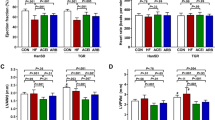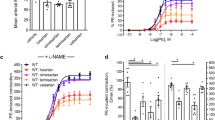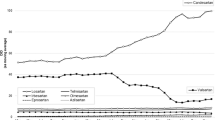Abstract
The prevalence of atrial fibrillation (AF) increases in patients with hypertension. Angiotensin II is involved in structural atrial remodeling, which contributes to the onset and maintenance of AF in paced animal models. We investigated the role of angiotensin II in atrial structural remodeling in rats with hypertension. Ten-week-old male Wistar-Kyoto rats were randomly divided into 4 groups: a control group (no treatment), an Nω-nitro-L-arginine methyl ester (L-NAME) group (administered L-NAME, an inhibitor of nitric oxide synthase, 1 g/l in drinking water), an L-NAME+candesartan group (L-NAME plus candesartan—an angiotensin II receptor blocker (ARB)—at 0.1 mg/kg/day), and an L-NAME+hydralazine group (L-NAME plus hydralazine at 120 mg/l in drinking water). Eight weeks after treatment, the L-NAME group showed significantly higher systolic blood pressure than the control group (197±12 vs.138±5 mmHg, p<0.05). Candesartan or hydralazine with L-NAME reduced systolic blood pressure to baseline. Chronic inhibition of NO synthesis increased the extent of fibrosis and transforming growth factor-β expression in atrial tissue, and both of these effects were prevented by candesartan, but not by hydralazine. Cardiac hypertrophy and dysfunction were induced in the L-NAME group, and these effects were also prevented by candesartan, but not by hydralazine. In contrast, the decrease in thrombomodulin expression in the atrial endocardium in hypertensive rats was restored by candesartan and hydralazine. The ARB prevented atrial structural remodeling, a possible contributing factor for the development of AF, in the hearts of rats with hypertension induced by long-term inhibition of NO synthesis.
Similar content being viewed by others
Article PDF
References
Benjamin EJ, Wolf PA, D'Agostino RB, Silbershatz H, Kannel WB, Levy D : Impact of atrial fibrillation on the risk of death: the Framingham Heart Study. Circulation 1998; 98: 946–952.
Wang TJ, Larson MG, Levy D, et al: Temporal relations of atrial fibrillation and congestive heart failure and their joint influence on mortality: the Framingham Heart Study. Circulation 2003; 107: 2920–2925.
Minamino T, Kitakaze M, Sanada S, et al: Increased expression of P-selectin on platelets is a risk factor for silent cerebral infarction in patients with atrial fibrillation: role of nitric oxide. Circulation 1998; 98: 1721–1727.
Minamino T, Kitakaze M, Asanuma H, et al: Plasma adenosine levels and platelet activation in patients with atrial fibrillation. Am J Cardiol 1999; 83: 194–198.
Minamino T, Kitakaze M, Sato H, et al: Plasma levels of nitrite/nitrate and platelet cGMP levels are decreased in patients with atrial fibrillation. Arterioscler Thromb Vasc Biol 1997; 17: 3191–3195.
Verdecchia P, Reboldi G, Gattobigio R, et al: Atrial fibrillation in hypertension: predictors and outcome. Hypertension 2003; 41: 218–223.
Li D, Fareh S, Leung TK, Nattel S : Promotion of atrial fibrillation by heart failure in dogs: atrial remodeling of a different sort. Circulation 1999; 100: 87–95.
Kumagai K, Nakashima H, Urata H, Gondo N, Arakawa K, Saku K : Effects of angiotensin II type 1 receptor antagonist on electrical and structural remodeling in atrial fibrillation. J Am Coll Cardiol 2003; 41: 2197–2204.
Shinagawa K, Li D, Leung TK, Nattel S : Consequences of atrial tachycardia-induced remodeling depend on the preexisting atrial substrate. Circulation 2002; 105: 251–257.
Cohn JN, Ferrari R, Sharpe N, on behalf of an International Forum on Cardiac Remodeling : Cardiac remodeling—concepts and clinical implications: a consensus paper from an international forum on cardiac remodeling. J Am Coll Cardiol 2000; 35: 569–582.
Schnee JM, Hsueh WA : Angiotensin II, adhesion, and cardiac fibrosis. Cardiovasc Res 2000; 46: 264–268.
Weber KT, Brilla CG : Pathological hypertrophy and cardiac interstitium. Fibrosis and renin-angiotensin-aldosterone system. Circulation 1991; 83: 1849–1865.
Tanemoto M, Abe T, Obara N, Abe M, Satoh F, Ito S : Successful treatment of severe hypertension with the combination of angiotensin converting enzyme inhibitor and angiotensin II receptor blocker. Hypertens Res 2003; 26: 863–868.
Vermes E, Tardif JC, Bourassa MG, et al: Enalapril decreases the incidence of atrial fibrillation in patients with left ventricular dysfunction: insight from the Studies of Left Ventricular Dysfunction (SOLVD) trials. Circulation 2003; 107: 2926–2931.
Maggioni AP, Latini R, Carson PE, et al: Valsartan reduces the incidence of atrial fibrillation in patients with heart failure: results from the Valsartan Heart Failure Trial (Val-HeFT). Am Heart J 2005; 149: 548–557.
Miura S, Saku K, Karnik SS : Molecular analysis of the structure and function of the angiotensin II type 1 receptor. Hypertens Res 2003; 26: 937–943.
Shi Y, Li D, Tardif JC, Nattel S : Enalapril effects on atrial remodeling and atrial fibrillation in experimental congestive heart failure. Cardiovasc Res 2002; 54: 456–461.
Wachtell K, Lehto M, Gerdts E, et al: Angiotensin II receptor blockade reduces new-onset atrial fibrillation and subsequent stroke compared to atenolol: the Losartan Intervention for End Point Reduction in Hypertension (LIFE) study. J Am Coll Cardiol 2005; 45: 712–719.
Egashira K, Ni W, Inoue S, et al: Pravastatin attenuates cardiovascular inflammatory and proliferative changes in a rat model of chronic inhibition of nitric oxide synthesis by its cholesterol-lowering independent actions. Hypertens Res 2000; 23: 353–358.
Yamashita T, Sekiguchi A, Iwasaki YK, et al: Thrombomodulin and tissue factor pathway inhibitor in endocardium of rapidly paced rat atria. Circulation 2003; 108: 2450–2452.
Li-Saw-Hee FL, Blann AD, Lip GY : A cross-sectional and diurnal study of thrombogenesis among patients with chronic atrial fibrillation. J Am Coll Cardiol 2000; 35: 1926–1931.
Kubo SH, Rector TS, Bank AJ, Williams RE, Heifetz SM : Endothelium-dependent vasodilation is attenuated in patients with heart failure. Circulation 1991; 84: 1589–1596.
Panza JA, Quyyumi AA, Brush JE Jr, Epstein SE : Abnormal endothelium-dependent vascular relaxation in patients with essential hypertension. N Engl J Med 1990; 323: 22–27.
Node K, Kitakaze M, Yoshikawa H, Kosaka H, Hori M : Reduced plasma concentrations of nitrogen oxide in individuals with essential hypertension. Hypertension 1997; 30: 405–408.
Ribeiro MO, Antunes E, de Nucci G, Lovisolo SM, Zatz R : Chronic inhibition of nitric oxide synthesis. A new model of arterial hypertension. Hypertension 1992; 20: 298–303.
Minamino T, Kitakaze M, Papst PJ, et al: Inhibition of nitric oxide synthesis induces coronary vascular remodeling and cardiac hypertrophy associated with the activation of p70 S6 kinase in rats. Cardiovasc Drugs Ther 2000; 14: 533–542.
Kuwahara F, Kai H, Tokuda K, et al: Transforming growth factor-beta function blocking prevents myocardial fibrosis and diastolic dysfunction in pressure-overloaded rats. Circulation 2002; 106: 130–135.
Hoit BD : Matrix metalloproteinases and atrial structural remodeling. J Am Coll Cardiol 2003; 42: 345–347.
Yue L, Feng J, Gaspo R, Li GR, Wang Z, Nattel S : Ionic remodeling underlying action potential changes in a canine model of atrial fibrillation. Circ Res 1997; 81: 512–525.
Cha TJ, Ehrlich JR, Zhang L, Nattel S : Atrial ionic remodeling induced by atrial tachycardia in the presence of congestive heart failure. Circulation 2004; 110: 1520–1526.
Takemoto M, Egashira K, Usui M, et al: Important role of tissue angiotensin-converting enzyme activity in the pathogenesis of coronary vascular and myocardial structural changes induced by long-term blockade of nitric oxide synthesis in rats. J Clin Invest 1997; 99: 278–287.
Cohn JN, Tognoni G : A randomized trial of the angiotensin-receptor blocker valsartan in chronic heart failure. N Engl J Med 2001; 345: 1667–1675.
Dahlof B, Herlitz H, Aurell M, Hansson L : Reversal of cardiovascular structural changes when treating essential hypertension. The importance of the renin-angiotensin-aldosterone system. Am J Hypertens 1992; 5: 900–911.
Zou Y, Akazawa H, Qin Y, et al: Mechanical stress activates angiotensin II type 1 receptor without the involvement of angiotensin II. Nat Cell Biol 2004; 6: 499–506.
Border WA, Noble NA : Transforming growth factor beta in tissue fibrosis. N Engl J Med 1994; 331: 1286–1292.
Kawano H, Do YS, Kawano Y, et al: Angiotensin II has multiple profibrotic effects in human cardiac fibroblasts. Circulation 2000; 101: 1130–1137.
Esmon CT : The roles of protein C and thrombomodulin in the regulation of blood coagulation. J Biol Chem 1989; 264: 4743–4746.
Takemoto M, Egashira K, Tomita H, et al: Chronic angiotensin-converting enzyme inhibition and angiotensin II type 1 receptor blockade: effects on cardiovascular remodeling in rats induced by the long-term blockade of nitric oxide synthesis. Hypertension 1997; 30: 1621–1627.
Author information
Authors and Affiliations
Corresponding author
Rights and permissions
About this article
Cite this article
Okazaki, H., Minamino, T., Tsukamoto, O. et al. Angiotensin II Type 1 Receptor Blocker Prevents Atrial Structural Remodeling in Rats with Hypertension Induced by Chronic Nitric Oxide Inhibition. Hypertens Res 29, 277–284 (2006). https://doi.org/10.1291/hypres.29.277
Received:
Accepted:
Issue date:
DOI: https://doi.org/10.1291/hypres.29.277
Keywords
This article is cited by
-
Sacubitril/Valsartan Decreases Atrial Fibrillation Susceptibility by Inhibiting Angiotensin II-Induced Atrial Fibrosis Through p-Smad2/3, p-JNK, and p-p38 Signaling Pathways
Journal of Cardiovascular Translational Research (2022)
-
Clinical implication of disturbed left atrial phasic functions in the heterogeneous population associated with hypertension or atrial fibrillation
Cardiovascular Ultrasound (2019)
-
Strain/strain rate imaging of impaired left atrial function in patients with metabolic syndrome
Hypertension Research (2015)
-
Favorable cardiac and aortic remodeling in olmesartan-treated spontaneously hypertensive rats
Heart and Vessels (2009)
-
Rationale for phosphodiesterase 5 inhibitor use post-radical prostatectomy: experimental and clinical review
International Journal of Impotence Research (2008)



